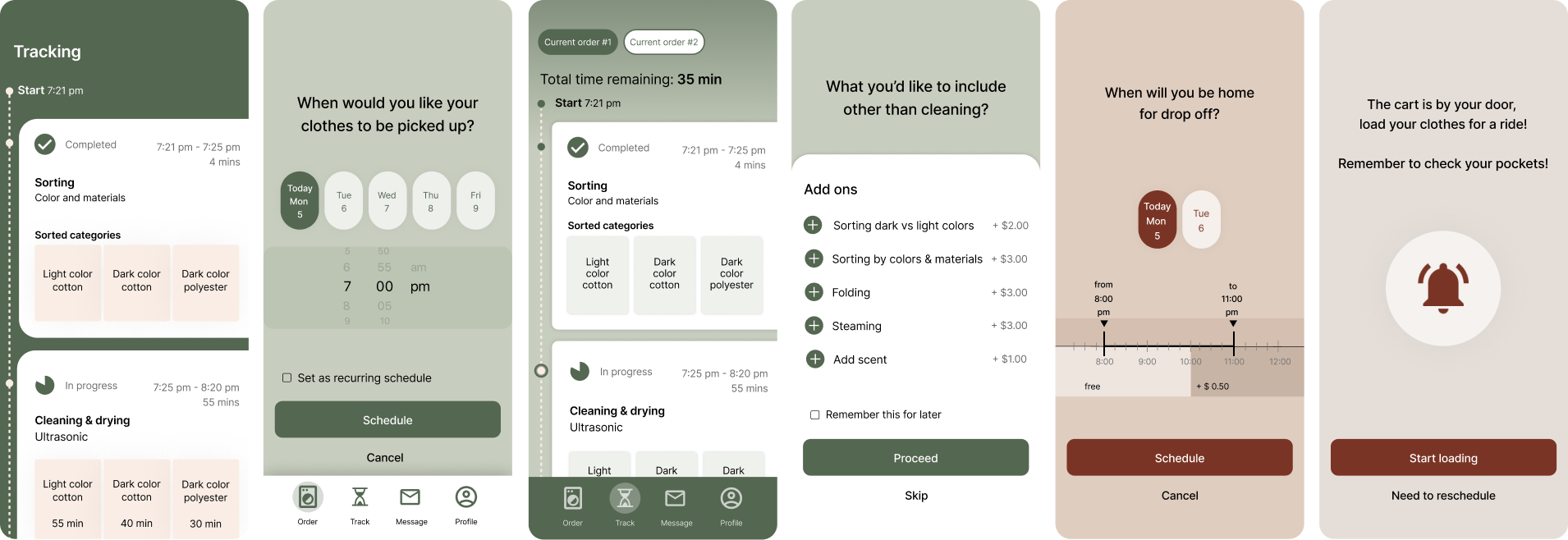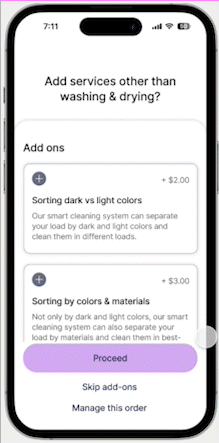The secret life of laundry machine, Sparkle
Sparkle is a laundry service designed for buildings with shared laundry rooms, a common arrangement in urban areas where rent is high. This autonomous system offers comprehensive services for each step of the laundry cycle, including picking up laundry from the unit, sorting, cleaning, folding, and dropping it off. Instead of having to carry their laundry to the laundry room and set alarms to unload, users can now simply schedule the Sparkle cart at their convenience. They will then find their laundry conveniently delivered back to their unit, all handled with just a few taps on their phone.
At a glance
This is a project for my MDes program, and the topic is to make an existing object autonomous, with solid problem space and feasible technology.
The ask
me + Kshitija Dhumal, Lakshmi Ajayan
Team
research, ideation, branding, wireframe, UI
Role
Duration
3 weeks
Early research
The team picked shared laundry machines collectively, as the conventional laundry task has a few prominent challenges.
“unpaid labor”
women ages 35-44 spend 8.8 h/day on unpaid work and men spend 5.2h
(The 2018 American Time Use Survey)
water usage
the average water usage for washing machine in U.S. is 5400 gallon (20440L) per person per year
(US Environmental Protection Agency)
generated by Midjourney
mental health
laundry gets even harder for those who are already suffering from mental health concerns
(KC Davis, LPC)
living with intent
the pandemic has made almost 60% people more thoughtful about how their time is spent
(US Consumers Survey, HBO Max, 2021)
User research
We then talked to 7 people and learned about their experience about using shared laundry room.
Time consumed, mental burden, and carrying laundry physically to the far laundry room was common concerns. Although people have different habits of doing their laundry, we were able to group them into 2 main archetypes.
With the detailed journey map based on the user behaviors we learned, we realized that there are many touchpoints during the entire process. User have to carve time for the entire process and return to laundry at least 3 times. They are also many decision making in sorting and setting up the machine.
We consolidated all the challenges and narrowed down to a clear goal -
to create a seamless system that reduces the touchpoints, as well as the effort and time spent sorting, carrying, and folding laundry.
Related technologies
Before we began ideation, we also studied the current state of laundry cleaning technologies and learned how new materials require distinct cleaning methods.
New ways to clean
The Entry by lighting tech company Healthe uses far-UVC light to sanitize clothes and belongings as people enter a space.
P&G sent Tide Infinity powder to the International Space Station for use in closed-loop water systems, aiming for low-impact laundry solutions on Earth.
At its new Broadway repair center, Arc'teryx offers special fabric care, including tech wash services and face fabric renewal.
Ultrasonic cleaners like Sonic Soak are gaining popularity for laundry, offering efficient cleaning and bacteria elimination. They use 20 times less energy and significantly reduce water usage. These machines provide microscopic-scale garment cleaning without causing wear and tear.
Clothing material
Antimicrobial fabrics can keep frequently worn underwear and sportswear fresher longer by combating odo
Plant-based, stay-fresh finishes and leakproof tech in intimate apparel can boost consumer confidence by reducing laundry needs.
Beyond just cleaning
Panasonic recently invested $60 million in Laundroid, the world's first laundry-folding robot. With multiple cameras and robotic arms, Laundroid scans laundry loads and uses Wi-Fi to connect to a server for AI-assisted folding analysis. Its companion app tracks each clothing item processed, categorizing clothes by a household member.

Early wireframes & sketches
More ideas
Early UI explorations
Key features & final experience
Scheduling a pickup
Availability of laundry machines
Other units’ schedules
Maintenance of machines
Learns scheduling habits and reminds people to schedule
Sparkle cart arrives at unit
Loading Sparkle cart with dirty clothes
The app sends notification, just like ringing a doorbell
Factors influencing slot availability
Pattern recognition over time
User opens the cart door following the instruction on the app, loads the laundry, and confirm when done
Input preferences & scheduling drop-off
Beyond the basic cleaning feature, there are optional add-ons such as sorting, folding, steaming, and scent
Cart transfers laundry into cleaning system
Based on the cleaning preferences and add-ons, the cart will drop clothes in the corresponding compartment to start the cycle
Cleaning & tracking
While the Sparkle cleaning system is working, the process can be tracked on the app
Sparkle cart drops off clean clothes
Cart delivers clean clothes back to unit at scheduled time, with option to reschedule drop off
Illustration credit: Kshitija Dhumal
Edge case scenarios
Scenario 1
The obstacle
Sparkle cart is unable to reach the user’s door as an obstacle is blocking the entire hallway.
Sparkle automatically notifies admin/maintenance and informs the user about the situation
If it’s after office hours, Sparkle will offer appropriate options
Scenario 2
The busy day
Sparkle is unable to cater to the surge in wash requests on the day before holidays/travel season starts
Scenario 3
The broken machine
One of Sparkle machines breaks down during the cycle
Clothes will be transferred to the next available machine
The app notifies the user about the situation and informs change in ETA if any
The app notifies other scheduled users in case of subsequent unavailability of machines
Solution
Solution
Solution
Prevention: Sparkle reminds users to do laundry before typical peak times
During peak time: Londro offers the option to pay an express fee to cut the line
Learnings
In this group project, the team went through rounds of ideation for the entire Sparkle service system, which included the cleaning machine, the cart, and the app. Initially, the three of us each had very different directions in mind, and our ideas were spread widely. It was fascinating to see how a sea of ideas eventually turned into one seamless experience.
This was also my first time designing physical objects and my first time illustrating in 3D.
































